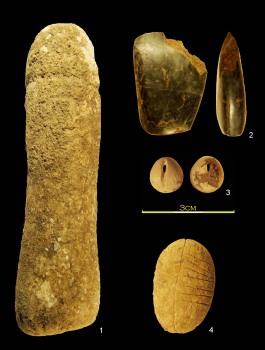On the site were found the bones of a man, phallic-shaped figurines, jewelry and hunting tools brought from afar

An archaeological expedition of the Hebrew University led by Prof. Nigel Goring-Morris recently uncovered in Kfar Horesh a burial complex from the Pre-Ceramic Neolithic period B, a period dating from around 8,500-6,750 BC. A single burial of a man at least 40 years old who was buried in a contracted position was found in the compound. A sickle blade and a sea shell were placed in the burial as offerings and more than 60 shells were found concentrated near the burial.
The burial complex is bounded by two massive walls measuring 10x20 m that form the 'R' shape. Near the burial complex were also found flint tools, grinding and crushing tools and animal bones, mainly of hunted animals such as deer and wild boar, as well as symbolic items such as small "tokens" some of which are decorated with engravings. Although this period is known for the abundance of female fertility symbols, so far only figurines with a phallic shape have been found in Kfar Horesh.
The trade relations in the area are evidenced by other findings such as shells and shell jewelry from the Mediterranean and Red Seas, exotic minerals originating from the south of the Dead Sea, natural volcanic glass from Turkey, as well as a small Vetibi ax made of serpentine that probably originated in Cyprus or northern Syria.
The Pre-Ceramic Neolithic period B is the period in which large agricultural communities first appear in the fertile regions of the Near East. At that time, an arena of intercultural interaction is created in our region, the human population continues to grow, the construction of rectangular buildings becomes common and ritual and public buildings begin to appear. Although hunting and gathering were important subsistence strategies, domesticated animals and plants begin to take a more important place in human existence during this period. Ritual objects and installations found in the area indicate an intense ritual life. Luxury items and symbols of prestige were sometimes traded across vast distances.
"The economic processes also brought with them social tensions that increased as the distribution of material, social and ritual wealth within the community and between communities became less equal," claims Prof. Goring-Morris. "These tensions are reflected in the various burial customs of the period, which include primary burial within the settlement, often accompanied by the custom of removing the skulls, as well as secondary and multiple burials."
Kfar Horesh, which sits in the Nazareth Mountains in the Lower Galilee, was seen in the study as a regional burial site and as a ritual center that was used by the agricultural villages around it. At least 65 burials have been identified there so far and most of them are young men. The nature of the burials is very diverse and they range from primary single burials to secondary burials in which up to 17 people are buried. In one of the burials, the bones were even placed in a shape that creates the image of an animal.

One response
Indeed, this is how history is plowed, dug... and sewn.